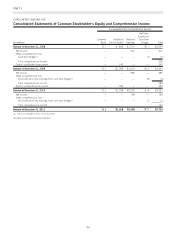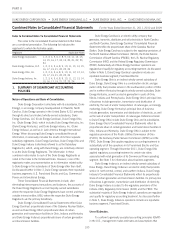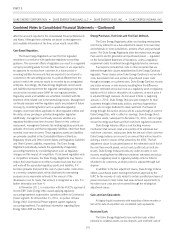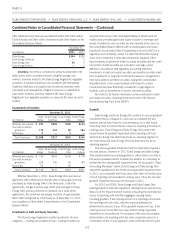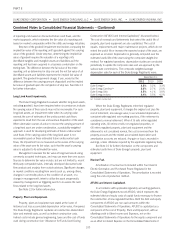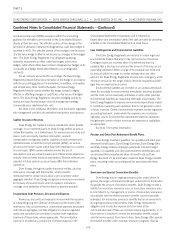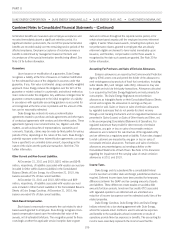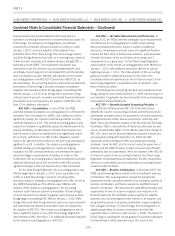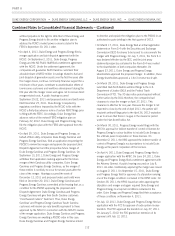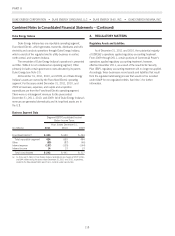Duke Energy 2011 Annual Report Download - page 129
Download and view the complete annual report
Please find page 129 of the 2011 Duke Energy annual report below. You can navigate through the pages in the report by either clicking on the pages listed below, or by using the keyword search tool below to find specific information within the annual report.
PART II
DUKE ENERGY CORPORATION •DUKE ENERGY CAROLINAS, LLC •DUKE ENERGY OHIO, INC. •DUKE ENERGY INDIANA, INC.
Combined Notes to Consolidated Financial Statements – (Continued)
financial assets) and required additional disclosures about a
transferor’s continuing involvement in transferred financial assets. For
Duke Energy, this revised accounting guidance was effective
prospectively for transfers of financial assets occurring on or after
January 1, 2010, and early adoption of this statement was
prohibited. Since 2002, Duke Energy Ohio, Duke Energy Indiana,
and Duke Energy Kentucky have sold, on a revolving basis, nearly all
of their accounts receivable and related collections through CRC, a
bankruptcy-remote QSPE. The securitization transaction was
structured to meet the criteria for sale accounting treatment, and
accordingly, Duke Energy did not consolidate CRC, and the transfers
were accounted for as sales. Effective with adoption of this revised
accounting guidance and ASC 810-Consolidation (ASC 810), as
discussed below, the accounting treatment and/or financial statement
presentation of Duke Energy’s accounts receivable securitization
programs was impacted as Duke Energy began consolidating CRC
effective January 1, 2010. Duke Energy Ohio’s and Duke Energy
Indiana’s sales of accounts receivable and related financial statement
presentation were not impacted by the adoption of ASC 860. See
Note 17 for additional information.
ASC 810 — Consolidations. In June 2009, the FASB
amended existing consolidation accounting guidance to eliminate the
exemption from consolidation for QSPEs, and clarified, but did not
significantly change, the criteria for determining whether an entity
meets the definition of a VIE. This revised accounting guidance also
required an enterprise to qualitatively assess the determination of the
primary beneficiary of a VIE based on whether that enterprise has
both the power to direct the activities that most significantly impact
the economic performance of a VIE and the obligation to absorb
losses or the right to receive benefits of a VIE that could potentially be
significant to a VIE. In addition, this revised accounting guidance
modified existing accounting guidance to require an ongoing
evaluation of a VIE’s primary beneficiary and amended the types of
events that trigger a reassessment of whether an entity is a VIE.
Furthermore, this accounting guidance required enterprises to provide
additional disclosures about their involvement with VIEs and any
significant changes in their risk exposure due to that involvement.
For the Duke Energy Registrants, this accounting guidance was
effective beginning on January 1, 2010, and is applicable to all
entities in which Duke Energy is involved, including entities
previously subject to existing accounting guidance for VIEs, as well as
any QSPEs that existed as of the effective date. Effective with
adoption of this revised accounting guidance, the accounting
treatment and/or financial statement presentation of Duke Energy’s
accounts receivable securitization programs were impacted as Duke
Energy began consolidating CRC effective January 1, 2010. Duke
Energy Ohio’s and Duke Energy Indiana’s sales of accounts receivable
and related financial statement presentation were not impacted by
the adoption of ASC 810. This revised accounting guidance did not
have a significant impact on any of the Duke Energy Registrants’
other interests in VIEs. See Note 17 for additional disclosures required
by the revised accounting guidance in ASC 810.
ASC 820 — Fair Value Measurements and Disclosures. In
January 2010, the FASB amended existing fair value measurements
and disclosures accounting guidance to clarify certain existing
disclosure requirements and to require a number of additional
disclosures, including amounts and reasons for significant transfers
between the three levels of the fair value hierarchy, and presentation
of certain information in the reconciliation of recurring Level 3
measurements on a gross basis. For the Duke Energy Registrants,
certain portions of this revised accounting guidance were effective on
January 1, 2010, with additional disclosures effective for periods
beginning January 1, 2011. The initial adoption of this accounting
guidance resulted in additional disclosure in the notes to the
consolidated financial statements but did not have an impact on the
Duke Energy Registrants’ consolidated results of operations, cash
flows or financial position.
The following new accounting standards were adopted by Duke
Energy during the year ended December 31, 2009 and the impact of
such adoption, if applicable has been presented in the accompanying
Consolidated Financial Statements:
ASC 105 — Generally Accepted Accounting Principles. In
June 2009, the FASB amended ASC 105 for the ASC, which
identifies the sources of accounting principles and the framework for
selecting the principles used in the preparation of financial statements
of nongovernmental entities that are presented in conformity with
GAAP. Rules and interpretive releases of the Securities and Exchange
Commission (SEC) under authority of federal securities laws are also
sources of authoritative GAAP. On the effective date of the changes to
ASC 105, which was for financial statements issued for interim and
annual periods ending after September 15, 2009, the ASC
supersedes all then-existing non-SEC accounting and reporting
standards. Under the ASC, all of its content carries the same level of
authority and the GAAP hierarchy includes only two levels of GAAP:
authoritative and non-authoritative. While the adoption of the ASC did
not have an impact on the accounting followed in the Duke Energy
Registrants’ consolidated financial statements, the ASC impacted the
references to authoritative and non-authoritative accounting literature
contained within the Notes.
ASC 805 — Business Combinations. In December 2007, the
FASB issued revised guidance related to the accounting for business
combinations. This revised guidance retained the fundamental
requirement that the acquisition method of accounting be used for all
business combinations and that an acquirer be identified for each
business combination. This statement also established principles and
requirements for how an acquirer recognizes and measures in its
financial statements the identifiable assets acquired, the liabilities
assumed, any noncontrolling (minority) interests in an acquiree, and
any goodwill acquired in a business combination or gain recognized
from a bargain purchase. For Duke Energy, this revised guidance is
applied prospectively to business combinations for which the
acquisition date occurred on or after January 1, 2009. The impact to
Duke Energy of applying this revised guidance for periods subsequent
to implementation will be dependent upon the nature of any
109


